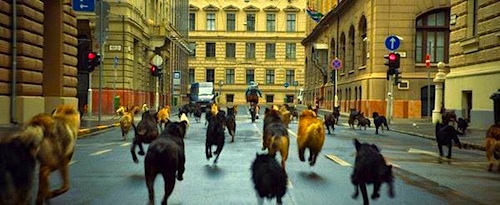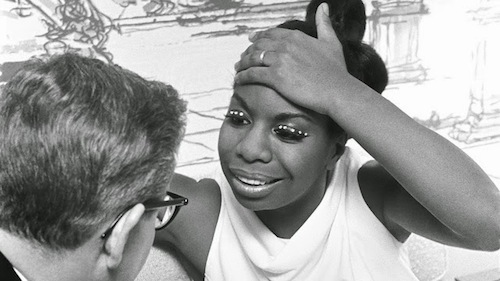By Joe Bendel. It is like a cross between the Incredible Journey and Willard/Ben franchises, but carrying the baggage of the recent rise of Hungarian nationalism. The underdogs are truly underdogs, but they will have their day in Kornél Mundruczó’s allegorical fable, White God, which screens during the 2015 Sundance Film Festival.
Much to everyone’s consternation, Lili and her faithful mutt Hagen must spend the summer with the father she barely knows. He is not crazy about it either, especially when a neighbor tips off the authorities to the noisy Hagen. To encourage purebreds and provide an ominous symbolic parallel, the authorities have levied a punitive tax on mixed mongrels, like the gentle Hagen.
Of course, Lili’s veritably deadbeat Daniel is not about to pay Hagen’s licensing fee, so he dumps him off by the side of the road. He is not the only one to get this idea. The confused Hagen soon falls in with a pack of newly wild mix-breeds, learning to evade the animal control thugs. Lili and Hagen try their best to find each other, but unfortunately, he falls into the hands of an underground dogfighting trainer, who hopes the mold Hagen into a contender through his savage conditioning.
When you get right down to it, Hagen’s story is more eventful that a complete Noah Baumbach retrospective, but he meets his destiny when he is finally captured and sent to the pound. Rather than simply wait to be euthanized, Hagen will rise up like Spartacus and lead a massive dog revolt. In all honesty, this is what most people will be going to White God to see—and it is pretty spectacular.
Lest anyone fret, White God was filmed using American guidelines for animal handling. No animals were harmed during the process. Presumably, no humans were either, but it is harder to be so definitive on that point. Regardless, the canines are all eerily expressive, particularly Luke and Bodie, who play Hagen. Three years ago, everyone’s tail was wagging for Uggie in The Artist, but the Labrador-sharpei-hound brothers take animal performance to a higher level.

Cinematographer Marcell Rév captures the action from a remarkable dog’s eye level. His intimate perspective really helps anthropomorphize the canines. His wide angle shots also powerfully render the apocalyptic third act. Oh, the human beings, Zsófia Psotta and Sándor Zsótér are not bad either, but her acting-out drama with older school mates gets a bit tiresome.
The White God title is apparently a half-baked reference to caste, creed, colonialism and everything else that imposes hierarchies on people, but even when the dog-pack is rampaging, the film never feels as clumsily didactic as that would suggest. Somehow, Mundruczó just flips the allegorical anarchy switch and we accept it. It is a pretty impressive feat of direction and animal handling. Indeed, Arpad Halasz and Teressa Miller (daughter of veteran handler Karl Lewis Miller, whose credits include Cujo and White Dog) are key collaborators in realizing Mundruczó’s vision. Hard to define but absolutely worth experiencing, White Dog screens again tomorrow (1/25) and next Saturday (1/31) in Park City, during this year’s Sundance Film Festival.
LFM GRADE: B+
Posted on January 24th, 2015 at 5:59pm.




